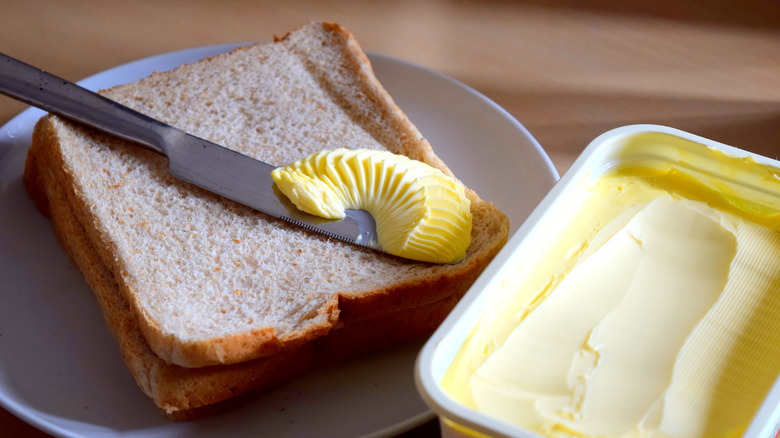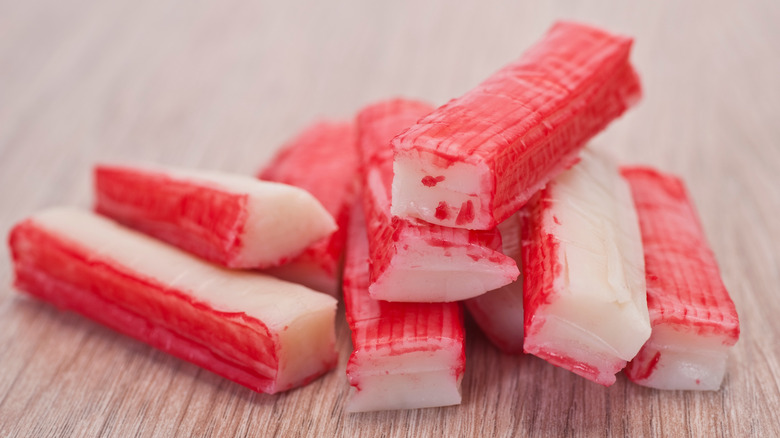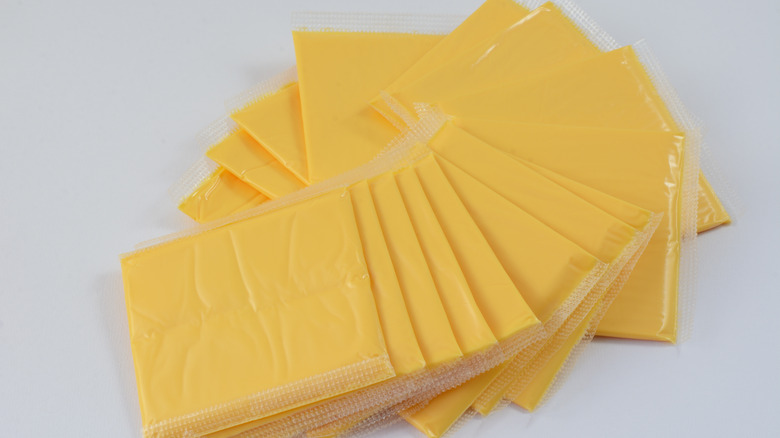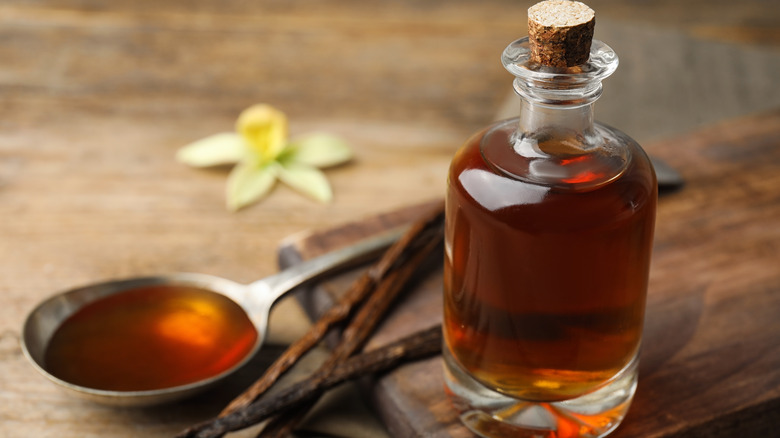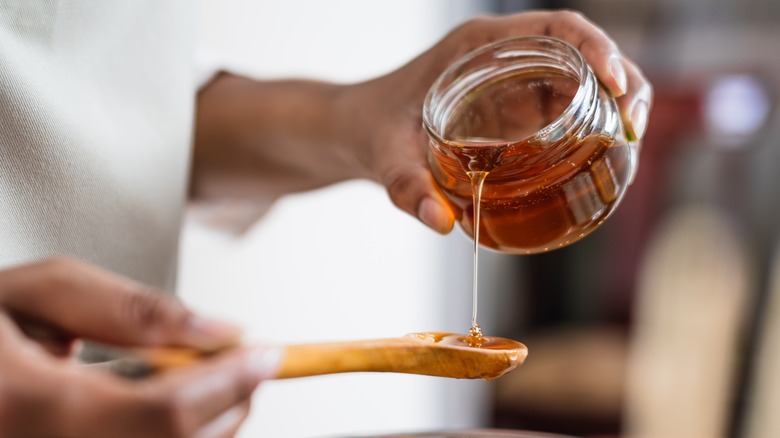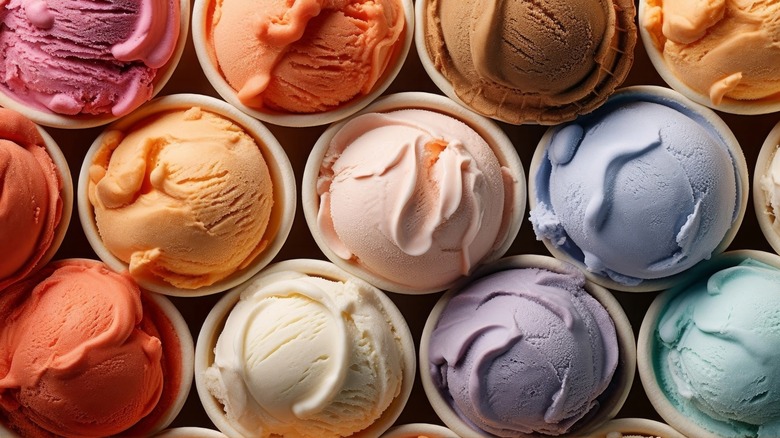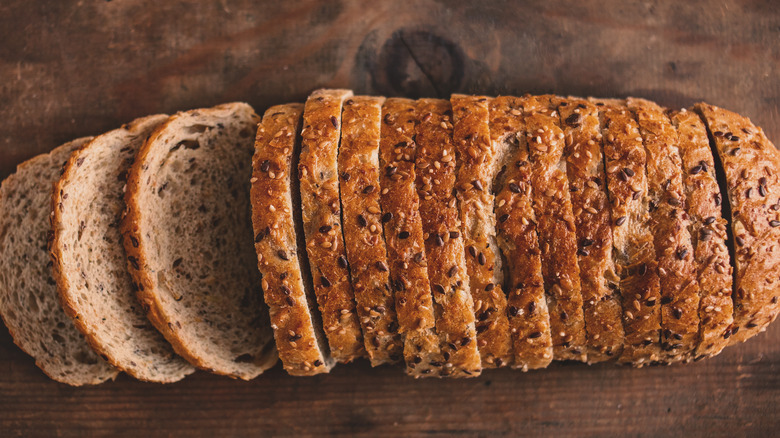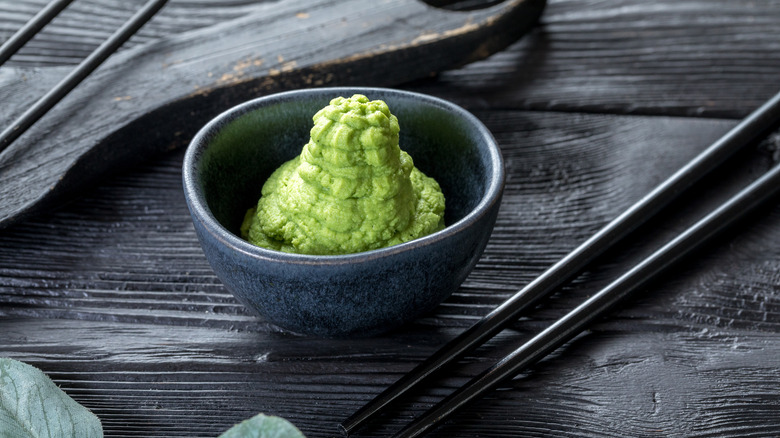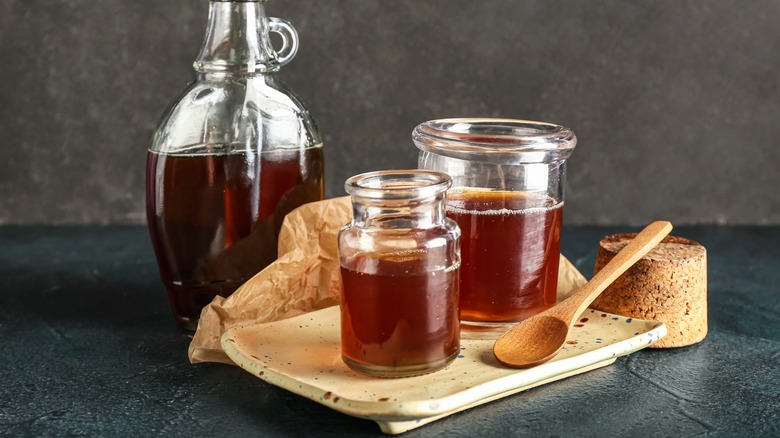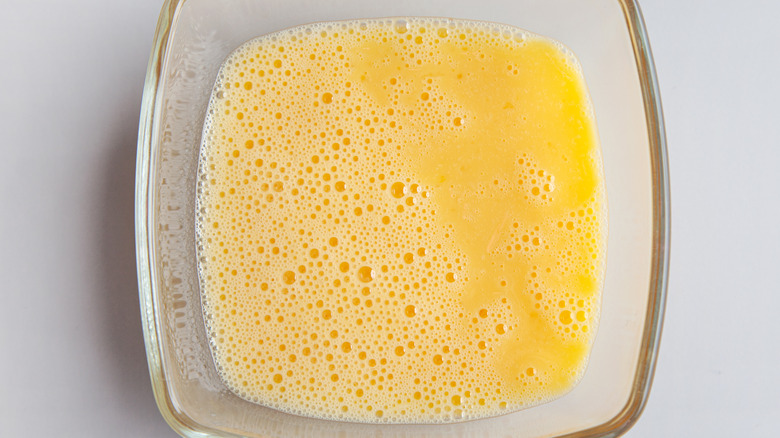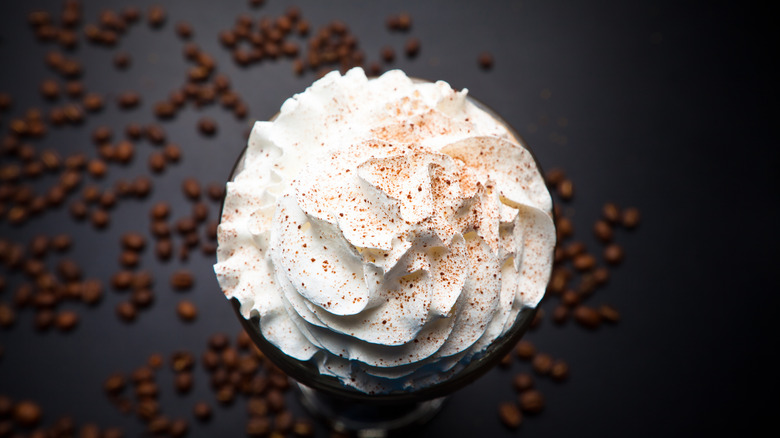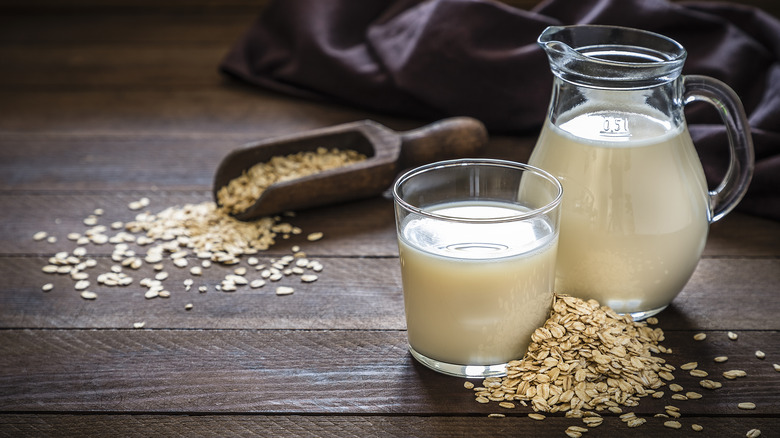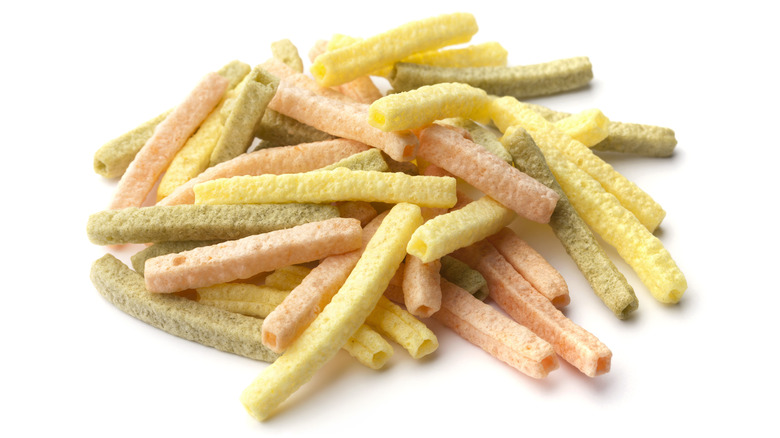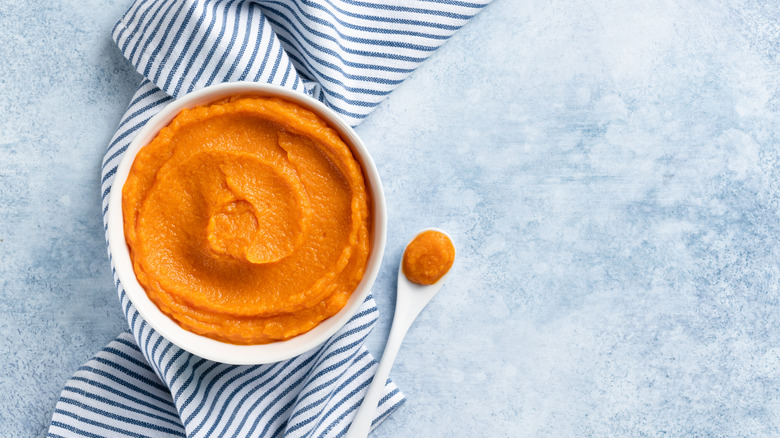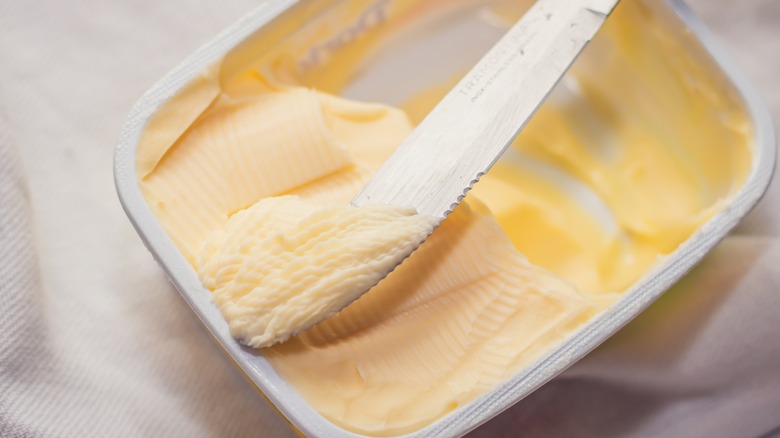7 Imitation Foods To Use And 7 You Might Want To Avoid
Most of the time, you can trust your food to be exactly what it says on the tin. But finding yourself with an imitation product, either by accident or as a result of food fraud, is a common issue. Food fraud costs the global food industry around 30 billion euros a year, according to the Food and Agriculture Organization of the United Nations, and it can result in consumers getting substandard products that could be less nutritious, or even hazardous to health.
Slightly less illegal, and more visible, is the imitation of certain food products, like crab in the form of seafood sticks, or pure vanilla in its artificially-produced form. These items tend to offer customers a version of the food that closely mirrors the original product, but at a fraction of the cost — and sometimes with worse quality. However, food imitation is not always a bad thing. While some imitation foods offer a pale version of the original, and leave consumers disappointed with a poor flavor and texture, other imitation foods are actually pretty decent. But with so many copycat items out there, how do you know which are worth your time and money, and which will waste your precious dollars? That's where we come in.
Use: Imitation crab
Imitation crab is one of the most widely available imitation foods. This meat product, which is most commonly seen in crab or seafood sticks, is made from something called surimi, a paste made from ground white fish. After being processed, shaped, and cooked, surimi closely imitates the texture, flavor, and appearance of crab — and while it can sometimes contain a small amount of the seafood, it can often get to the shelf without any crab in it whatsoever.
While purists might turn their nose up at imitation crab, though, it does have a few advantages. Imitation crab is way cheaper than real crab meat, allowing you to enjoy a close approximation of its taste at a fraction of the cost, and will likely be a better choice for people who eat crab more sparingly or casually. In addition, its easy-to-handle shape can make it way simpler to prepare than regular crab meat, particularly for novices who aren't used to cooking with seafood, as well as easier to snack on. Interestingly, too, imitation crab is lower in sodium than real crab, and it can also last way longer in the fridge than the real product. While it will never be able to fully replace the real thing, this product is definitely worth your time.
Avoid: American cheese
A staple item on burgers worldwide, American cheese is a pale imitation of the real thing. While many cheeses are made with care and love, slowly processing and aging the milk and dairy until it achieves a nutty, developed flavor, American cheese is created by smashing together multiple different cheese varieties, Frankenstein-style, and molding them into gooey, sticky, individually-wrapped rectangles. American cheese contains none of the complexity that regular cheeses do, and while it may melt well, it has a substandard, plasticky flavor, and an artificial-feeling texture.
As well as this, American cheese is a nightmare from a nutritional level. "Processed cheeses like American cheese are loaded with sodium and saturated fats, both of which can raise blood pressure levels and increase risk of stroke or heart attack," says registered dietitian Lori Walker via She Finds. "High cholesterol levels can also be a result of consuming too much processed cheese as they contain large amounts of cholesterol-raising saturated fats." Although regular cheese like cheddar or Swiss do also contain saturated fat, they also have protein, and some important minerals and vitamins — but they're also far more likely to be a better-tasting choice.
Use: Imitation vanilla
The debate of whether to use pure or imitation vanilla rages on to this day. Pure vanilla extract is comprised of vanilla beans and alcohol, as well as water, and because its main ingredient of vanilla beans is pricey and difficult to manufacture, it tends to sell at a high retail price. Imitation vanilla, meanwhile, is made with vanillin, a compound that comes from vanilla beans and which is way more affordable and easy to produce. This means that imitation vanilla is much cheaper, but some people argue that it has a poorer flavor.
The truth, though, is that most of the time, imitation vanilla is more than acceptable for your dishes. Both products can be used in interchangeable quantities, and when used in baked recipes, imitation vanilla gives a punchy vanilla flavor in the same way that real vanilla does at a fraction of the price. There are, however, occasions where real vanilla extract might be preferable, especially in dishes that require little or no cooking. In these applications, the vanilla taste will be way more noticeable, and you'll want the spicy, rich depth of real vanilla to make your food pop.
Avoid: Fake honey
It might surprise you to learn that a lot of honey out there isn't the real deal. Products labeled as "real," "100%," "raw," or "natural" are usually real honey, which comes straight from bees and hasn't been extensively processed. Fake honey, on the other hand, usually won't have such promises on the label. Instead, these items might be branded as a "honey product" or "imitation honey," and may also be described as being "ultrafiltered" or even "pure."
They will usually be combined with some kind of sweetener, and this gives them an unpleasantly sugary taste, with none of the complexity that real honey does. They may well be thinner too, with a runny consistency, and have a different color. While fake honey might be slightly cheaper than real honey, the regular product really isn't that pricey, so you're hardly getting a killer saving by choosing it.
Spotting fake honey can be harder if you're not in a position where you can check the bottle or jar it came in (if you're in a restaurant or hotel, for example). Luckily, there's a quick way to check. Drop a small amount of honey into some water, and see what happens. If it sinks to the bottom, it's real; if it starts to dissolve in the water, it's fake.
Use: Frozen dairy desserts
The thought of swapping out regular ice cream for a "frozen dairy dessert" is some people's idea of hell, but there's a lot to be said for doing so. Frozen dairy desserts are distinguished from regular ice cream by their levels of milkfat and aeration. Normal ice cream must have at least a 10% dairy milkfat content, and an "overrun" of no more than 100%, meaning that it must not be more than doubled in volume after it has air added to it. Frozen dairy desserts, on the other hand, don't have that kind of restriction, and can contain more air and less milkfat.
This sounds like it would make a worse product, and some people would argue, perhaps rightly, that frozen dairy desserts lack richness. But they have certain advantages that shouldn't be discounted. Frozen dairy desserts are generally lighter and airier than ice cream, and they can make an excellent choice when you just want something sweet but don't want a full bowl of something super-creamy. Furthermore, if you aren't precious about your milkfat content, they can still be flavorful, and may also be budget-friendly. Frozen dairy desserts may also be easier to scoop straight from the freezer, thanks to having more air in them, making them a superb option when you need something cold and sugary immediately.
Avoid: Multigrain breads
On the surface of things, multigrain bread sounds like a healthy option. The idea of bread which contains several different types of grains gives the impression of a product that has more nutrition and more fiber. That may not be the case, though. These breads are a poor imitation of what you actually want to be looking for – whole grain or whole wheat bread – and may not be significantly healthier than other types of bread, potentially being made with refined grains.
Whole grain or whole wheat bread, on the other hand, is made with intact wheat kernels, meaning that the end product is ultimately more nutritious. However, you should still keep an eye out for these types of bread's ingredient lists and nutritional values. Although some breads are labeled as "whole grain," this doesn't necessarily mean that they're made with 100% whole kernels, and instead may be a mix of whole grains and refined grains. As well as this, whole grain or whole wheat breads can still be high in sodium, or may have other additives added in that make them less healthy. Look for a high level of fiber, low sodium and added sugar levels, and a small ingredient list.
Use: Imitation wasabi
You might not know it, but the wasabi that your local sushi restaurant is using may not be the real thing. The vast majority of sushi restaurants opt for an imitation wasabi product instead of the real version. This imitation wasabi has no real wasabi in it whatsoever and instead is made from several other related plants and their derivatives, like horseradish and mustard powder, which supply a similar type of nose-burning heat. These products are then combined with green food coloring, to replicate the bright green tones of the wasabi plant.
This might sound like bare-faced imitation in broad daylight, but the truth is that imitation wasabi has several advantages. The product is way cheaper to make than real wasabi and is usually easier to find. Imitation wasabi will also last much longer than real wasabi will, allowing you to use it again and again. The real reason why we don't mind imitation wasabi that much, though, is that while it's always nice to have the real thing, the flavor of both products is so intense that you only need a tiny dab to get the desired effect. In such small quantities, you're likely to notice the difference — and as they create the same sense of heat, they have an identical sensory effect. Hey, if it's good enough for sushi restaurants, it's good enough for us.
Avoid: Fake maple syrup
Maple syrup is one of the most commonly imitated products out there, and the fact is that the fake thing can't hold a candle to the real stuff. Fake maple syrup doesn't go through any of the rigorous processes that regular maple syrup does, which involves tapping the trees for their sap and boiling and thickening it. Instead, fake maple syrup (which is often labeled as "pancake syrup") is made by combining ultra-sweet corn syrup with artificial maple extract, with the two combined and produced in industrial environments. The result is a syrup that looks like maple syrup but tastes overly sweet and bland.
Going for real maple syrup will usually see you spending more money, but what you'll get is a developed, flavorful product that doesn't just taste like sugar. Remember, though, you don't have to spend the earth to get a good maple syrup. Some maple syrups are sold at astonishingly high prices, but that doesn't mean that they're significantly better — and while you may wish to pay top dollar to support independent businesses, you can still get a good product at an acceptable cost.
Use: Imitation eggs
For some people, the idea of using imitation eggs instead of beating your own feels somewhat pointless. But there are a few advantages to imitation eggs that shouldn't be forgotten about. Imitation eggs are formulated to be vegan-friendly, and these days they're widely available and technologically advanced. "For years, vegans have been replacing eggs with homemade versions from flax, chia, tofu, and aquafaba, to name a few. Now an abundance of [store-bought] vegan egg alternatives exist," says certified nutritionist Amy Fox (via Martha Stewart). These egg alternatives usually come in a large, handy bottle or jug, allowing easy access and pouring. In contrast to regular eggs, which are fairly high in cholesterol, imitation eggs are cholesterol-free, while still providing protein and vitamins.
Imitation eggs are also very versatile and can slot into a number of baking recipes in place of real eggs. And they can also be used to replace eggs in the dishes where they're the star. "The liquid egg alternatives make for amazing scrambles and omelets," states Whole Foods Markets senior category merchant Clare Blunt. Bear in mind, though, that some imitation egg products may have added sodium, so always check the label before you buy.
Avoid: Whipped topping
If you don't have the energy to whip up some cream yourself, it can feel logical to reach for some whipped topping. But we would advise against doing so unless it's a last resort. The main problem with whipped topping is that it can be full of potentially unhealthy ingredients. Whipped toppings tend to be sweetened using high fructose corn syrup, a common sugar substitute that has been linked to higher rates of weight gain, diabetes, and high blood pressure (via Dr. Axe). These toppings may also contain unhealthy trans fats, particularly if you're buying them in a tub instead of a can.
Whipped topping also doesn't make sense financially. It tends to be way more expensive than regular whipping cream, due to the fact that you're paying for the convenience of it being ready to use. Whipped topping is also generally way less customizable than whipping your own cream — it's difficult to add in any additional flavors without flattening its consistency, as stirring in any extra tastes like vanilla extract will take the air out. Nor can you whip it to the exact texture that you'd like; you'll have to make do with what's in the can.
Use: Milk altenatives
Milk alternatives have been around for a while now, and their popularity is only set to increase. But despite this, there are still people who view plant-based milks as inferior to animal products — and in our view, this is a mistaken position to take. "There's really no downside to drinking plant-based milk instead of cow's milk," explains UCLA Health's senior dietitian Dana Ellis Hunnes, per UCLA Health. "Although milk is only one small part of a person's diet, plant-based milk along with a plant-forward diet offers many benefits for your health and the environment."
Plant-based milk alternatives are routinely lower in calories and fat than regular milk, and when they're unsweetened they also contain way less sugar. As plant-based milks are often fortified, you also don't miss out on any of the vitamins and minerals you'd normally get by drinking cow's milk. Plant-based milk is also hormone-free, taking away a common concern about drinking regular milk.
Environment-wise, plant-based milks have a number of advantages over regular milk. They generally take fewer physical resources to produce, with fewer land and water requirements, and this leads to them producing a lower level of emissions overall. And to top it all off, thanks to their increased availability, these once-niche products are now easy to find and affordable.
Avoid: Veggie straws
People who want to snack in a health-conscious manner, but still want the crunch and convenience of potato chips, might view veggie chips and straws as a good middle ground. But this deceptive imitation food is not as healthy as you might think. Veggie chips may be made from vegetables like parsnips or taro, but they're often still fried and dusted with sodium. Depending on the brand you choose, you may not be gaining that much health by opting for these over regular potato chips — especially if you view it as an opportunity to eat more.
There are also several types of veggie chips out there which are made from ground-up vegetables or pulses like chickpeas or lentils. But while these snacks may have a little more protein, they can sometimes have less fiber or sodium than regular chips. Veggie straws, another common vegetable-based snack, could be even worse. These snacks are often made from potato starch or flour, which essentially makes them a more processed version of potato chips. And because they're fried, they can contain high levels of fat, as well as sodium and other additives. Of course, it's totally fine to go for veggie chips or straws as a snack — just don't expect them to be super-healthy.
Use: Imitation pumpkin puree
When Thanksgiving rolls around, pumpkin puree shoots to the top of everyone's shopping list. And it might surprise you to find out that the "100% pumpkin" product you've just bought is actually an imitation food. Although these items often solely list pumpkin as an ingredient, the exact nature of the pumpkin inside may not be the bright orange globe you're familiar with. Canned pumpkins can be derived from a variety of squash products, and the FDA deems it acceptable to mix these up while still branding them as pure pumpkin.
However, this isn't necessarily a bad thing. Pumpkins are a type of squash, after all, and they don't have any distinct advantage over other varieties, beyond being culturally resonant with autumnal holidays. There are plenty of types of squash, like butternut, acorn, and delicata squash, which have a bright orange hue, giving pumpkin puree its vibrant, attractive color. As well as this, all of these types of squash taste just as good, and once they've been processed and put into a can, you're unlikely to be able to tell the difference – and we doubt your guests will be able to notice, either.
Avoid: Margarine
Margarine is arguably the most well-known imitation food out there. The spread was originally conceived as an affordable butter alternative in 19th century France, and to this day it's been a go-to option for people who want a butter-like fat without the cost. Unfortunately, margarine comes with a few health concerns, due to the hydrogenation process that the vegetable oil used to make it goes through. This hydrogenation creates additional saturated fat, and also trans fats. Trans fats can have a pretty heavy impact on your cholesterol levels, raising bad and lowering good cholesterol quantities in the bloodstream, which may affect your cardiovascular disease risk (via MedlinePlus).
Butter, on the other hand, does have saturated fats, but it generally has a way lower level of trans fats than margarine or shortening. It also has some useful natural nutrients like vitamin K2, and grass-fed butter may also have some healthy omega-3 fats in it. Butter is also way less processed than margarine, and is usually made up of fewer ingredients. Perhaps most important, though, is the taste factor. While some folks may prefer margarine for dietary reasons, butter has an inimitable creamy taste that the vegetable spread just can't compare to.
